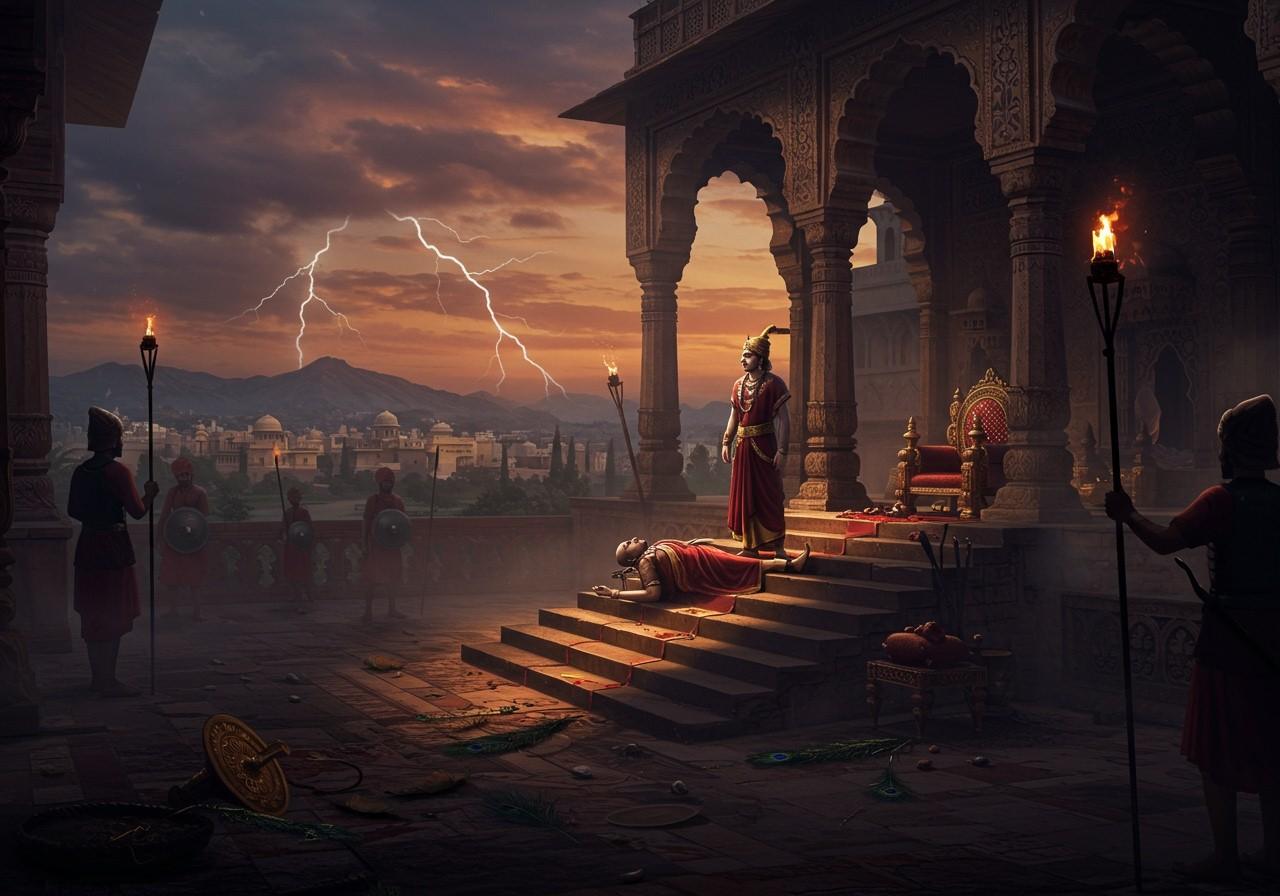
Ajatashatru, a pivotal figure in ancient Indian history (circa 492 to 460 BCE), significantly shaped the rise of the Magadha Empire. This blog delves into his lineage, the controversies surrounding his reign, and his lasting impact on India’s political and spiritual landscape.
Ajatashatru’s Family Background
Understanding Ajatashatru’s family dynamics offers valuable insights into the decisions and strategies that defined his rule.
King Bimbisara: The Foundation of the Magadha Empire
Ajatashatru’s father, King Bimbisara, was a remarkable ruler who laid the groundwork for Magadha’s future dominance. Ascending the throne at a young age, he strengthened the kingdom through strategic matrimonial alliances and astute policies.
- Early Life and Reign: Bimbisara’s kingship began in his youth, demonstrating his precocious leadership. His reign was marked by expansion and consolidation of power, setting the stage for Magadha’s prominence.
- Diplomatic Marriages and Alliances: Bimbisara’s strategic marriages to princesses from powerful kingdoms, including Kosala and Vaishali, forged crucial political alliances, bolstering Magadha’s influence and security.
- Relationship with Ajatashatru: The relationship between Bimbisara and Ajatashatru was fraught with tension, ultimately culminating in Bimbisara’s imprisonment and demise, a pivotal event that cast a long shadow over Ajatashatru’s reign. This succession struggle remains a subject of much historical debate.
Bimbisara’s influence on Ajatashatru, both in terms of administrative practices and military strategies, is undeniable. The foundation he built shaped Ajatashatru’s approach to governance and expansion.
Queen Chelna: An Influential Presence
Queen Chelna, Ajatashatru’s mother, held a significant position in the Magadha court. Her marriage to Bimbisara was a strategic alliance with the powerful Licchavi clan, further enhancing Magadha’s political standing.
- Background and Lineage: Chelna hailed from the influential Licchavi clan, known for their republican values and military prowess. This heritage undoubtedly shaped her perspective and influence within the Magadha court.
- Marriage to Bimbisara and its Political Significance: Her marriage to Bimbisara cemented a vital alliance between Magadha and the Licchavis, strengthening Magadha’s position in the region and contributing to its growing power.
- Influence on Ajatashatru and the Aftermath of Bimbisara’s Death: Chelna’s influence on Ajatashatru’s formative years and her reaction to Bimbisara’s tragic fate are important aspects of understanding the complexities of the period. The emotional and political ramifications of these events likely shaped her role and standing within the court.
Udayabhadra: Continuing the Magadha Legacy
Udayabhadra, Ajatashatru’s son, inherited the mantle of leadership and continued the expansion of the Magadha Empire. His rule represents a continuation of his father’s ambition and strategic vision.
- Upbringing and Early Influences: Growing up within the royal court, Udayabhadra was exposed to the political machinations and military strategies of his father, which undoubtedly shaped his own approach to governance.
- Accession to the Throne and Consolidation of Power: Udayabhadra’s ascension to the throne marked a new chapter in Magadha’s history. His reign focused on consolidating the gains made by his father and further expanding the empire’s reach.
- Policies and Campaigns: Udayabhadra’s policies reflected the influence of his father, continuing the focus on military strength and strategic alliances to maintain Magadha’s dominance.
Controversies and the Rise of Magadha
Ajatashatru’s reign was marked by significant controversies and strategic decisions that propelled Magadha’s rise to prominence.
Internal Conflicts and Political Intrigue
- Conflict with Bimbisara: The conflict with his father, Bimbisara, remains a controversial aspect of Ajatashatru’s reign. The power struggle that led to Bimbisara’s imprisonment and death raises questions about Ajatashatru’s motivations and the political climate of the time.
- Wars and Expansion: Ajatashatru’s aggressive expansionist policies led to wars with neighboring states, including the Licchavis and Kosala. His conquest of Vaishali marked a significant turning point in Magadha’s expansion, demonstrating his military strength and ambition.
- Patronage of Buddhism: Despite the ruthlessness attributed to him, Ajatashatru became a significant patron of Buddhism. His interactions with the Buddha and support for the growing religious movement played a role in its spread and development.
Strategies and Tactics
- Military Fortifications: Ajatashatru invested in strengthening Magadha’s defenses, constructing fortresses and strategic fortifications to protect his expanding empire from rivals and invaders.
- Urban Development: The development of Pataliputra as a major urban center reflects Ajatashatru’s vision for a powerful and prosperous capital. This strategic city played a key role in Magadha’s economic and administrative growth.
- Key Battles and Military Campaigns: Ajatashatru’s military campaigns against neighboring kingdoms, including the Licchavis and Kosala, were crucial in establishing Magadha’s dominance and expanding its territorial control.
Ajatashatru’s Legacy and Poojn.in
Ajatashatru’s legacy is complex and multifaceted. His ambition and controversial actions were intertwined with significant contributions to the growth and development of the Magadha Empire. His reign laid the groundwork for the Mauryan Empire, one of the largest empires in ancient India. His patronage of Buddhism played a crucial role in the religion’s early development and spread.
How Poojn.in Connects You to Ancient Traditions
Poojn.in, India’s leading online store for spiritual and cultural goods, offers a wide selection of products that can help you connect with the rich traditions of ancient India, including those relevant to Ajatashatru’s era. Explore our collection of puja items, sacred texts, and ritual accessories, carefully curated to support your spiritual practices and exploration of historical traditions.
- Ashoka Chal Powder: Discover the traditional uses of Ashoka bark, a sacred ingredient in Ayurvedic practices.
- Pooja Asan: Enhance your meditation and puja practices with a comfortable and traditional asan.
- Spiritual Idols and Sculptures: Find beautifully crafted idols and sculptures representing deities and figures from various spiritual traditions.
Visit www.poojn.in today to discover a wide array of products that can enrich your spiritual journey and connect you with the historical and cultural heritage of India.
Conclusion
Ajatashatru’s story is a compelling narrative of ambition, conflict, and transformation. His reign, though controversial, significantly shaped the trajectory of the Magadha Empire and left an indelible mark on ancient Indian history. His complex legacy continues to fascinate and inspire further exploration of this pivotal period.


